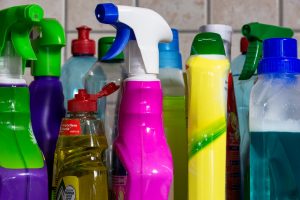 Based on what is currently known about the virus and similar strands that spread from person-to-person, infection happens most frequently among close contacts.
Based on what is currently known about the virus and similar strands that spread from person-to-person, infection happens most frequently among close contacts.
The transmission of coronavirus, in general, occurs much more commonly through respiratory droplets than through fomites. Current evidence suggests that SARS-CoV-2 may remain viable for hours to days on surfaces made from a variety of materials. Cleaning of visibly dirty surfaces followed by disinfection is one of the best practice measures for the prevention of spreading COVID-19 and other viral respiratory illnesses in community settings.
It is unknown how long the air inside a room occupied by someone confirmed to have COVID-19 remains potentially infectious. Facilities will need to consider factors such as the size of the room and the ventilation system design (including flowrate [air changes per hour] and location of supply and exhaust vents) when deciding how long to close off rooms or areas used by ill persons before beginning disinfection. Taking measures to improve ventilation in an area or room where someone who was confirmed or suspected to be infected with COVID-19 will help shorten the time it takes respiratory droplets to be removed from the air.
The following recommendations follow the Centers for Disease Control and Prevention guidelines as of April 2020.
Things to Remember
- Cleaning refers to the removal of dirt and impurities, including germs, from surfaces. Cleaning alone does not kill germs, but by removing the germs, it decreases their number and therefore any risk of spreading infection.
- Disinfecting works by using chemicals, EPA-registered disinfectants, for example, to kill germs on surfaces. This process does not necessarily clean dirty surfaces or remove germs, but killing germs remaining on a surface after cleaning further reduces any risk of spreading infection.
How to Clean and Disinfect
Personal Protective Equipment (PPE)
Wear disposable gloves and gowns for all tasks in the cleaning process, including handling trash.
- Gloves and gowns should be compatible with the disinfectant products being used.
- Additional PPE might be required based on the cleaning/disinfectant products being used, and whether there is a risk of splash.
- Gloves should be removed after cleaning a room or area occupied by ill persons.
- Gloves and gowns should be removed carefully to avoid contamination of the wearer and the surrounding area. Clean hands immediately after gloves are removed.
- Employees should immediately report breaches in PPE such as a tear in gloves or any other potential exposures to their supervisor.
Hard (Non-porous) Surfaces
- If surfaces are dirty, they should be cleaned using a detergent or soap and water prior to disinfection.
- For disinfection, most common EPA-registered household disinfectants should be effective.
- Additionally, diluted household bleach solutions (at least 1000ppm sodium hypochlorite) can be used if appropriate for the surface. Follow manufacturer’s instructions for application, ensuring a contact time of at least 1 minute, and allowing proper ventilation during and after application. Check to ensure the product is not past its expiration date, and never mix household bleach with ammonia or any other cleanser. Unexpired household bleach will be effective against coronaviruses when properly diluted.
-
-
- Prepare a bleach solution by mixing 5 tablespoons (1/3 cup) bleach per gallon of water or 4 teaspoons bleach per quart of water.
-
Soft (Porous) Surfaces
- For soft (porous) surfaces, such as carpeted floors, rugs, and drapes, remove visible contamination if present and clean with appropriate cleaners indicated for use on these surfaces.
- After cleaning: If the items can be laundered, launder items in accordance with the manufacturer’s instructions using the warmest appropriate water setting for the items, and then dry items completely.
Electronics
- For electronics, such as tablets, touch screens, keyboards, remote controls, and ATMs, remove visible contamination if present.
- Follow the manufacturer’s instructions for all cleaning and disinfection products.
- Consider the use of wipeable covers for electronics.
- If no manufacturer guidance is available, consider the use of alcohol-based wipes or sprays containing at least 70% alcohol to disinfect touch screens. Dry surfaces thoroughly to avoid pooling of liquids
Linens, Clothing, and Other Items That Go in the Laundry
- In order to minimize the possibility of dispersing virus through the air, do not shake dirty laundry.
- Wash items in accordance with the manufacturer’s instructions. If possible, launder items using the warmest appropriate water setting and dry items completely.
- Clean and disinfect hampers or other carts for transporting laundry according to the guidance above for hard or soft surfaces.
Hand Hygiene
- Cleaning staff and others should clean hands often, including immediately after removing gloves and after contact with an ill person, by washing hands with soap and warm water for at least 20 seconds. If soap and water are not available and hands are not visibly dirty, an alcohol-based hand sanitizer that contains at least 60% alcohol may be used. However, if hands are visibly dirty, always wash hands with soap and water.
- Follow normal preventive actions while at work and home, including cleaning hands and avoiding touching eyes, nose, or mouth with unwashed hands.
KEMI does not assume liability for the content of information contained herein. Safety and health remain your responsibility. This information is to be used for informational purposes only and not intended to be exhaustive or a substitute for proper training, supervision or manufacturers’ instructions/recommendations. KEMI, by publication of this information, does not assume liability for damage or injury arising from reliance upon it. Compliance with this information is not a guarantee or warranty that you will be in conformity with any laws or regulations nor does it ensure the absolute safety of any person, place or object, including, but not limited to, you, your occupation, employees, customers or place of business.

